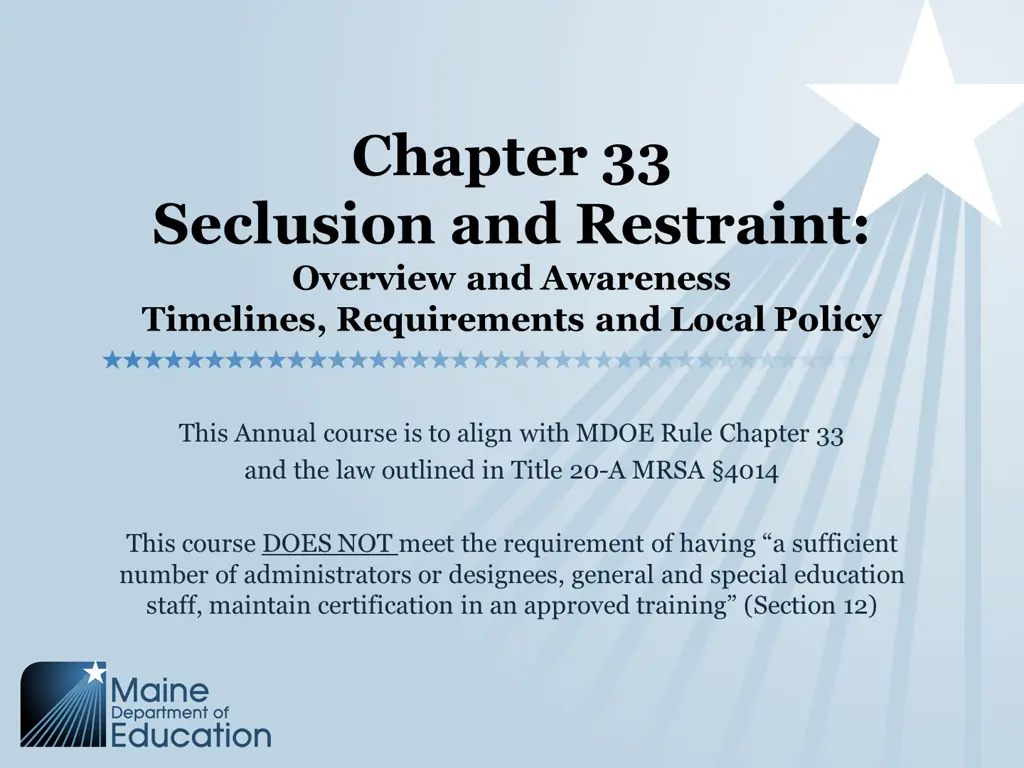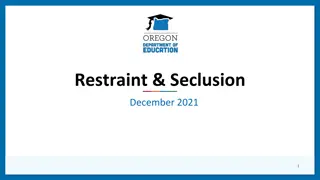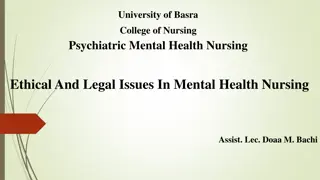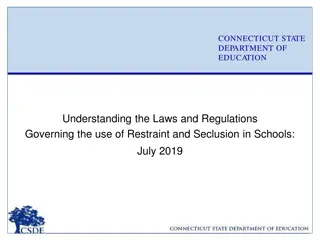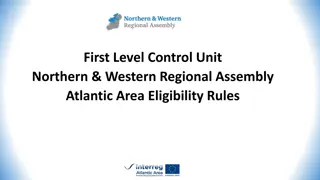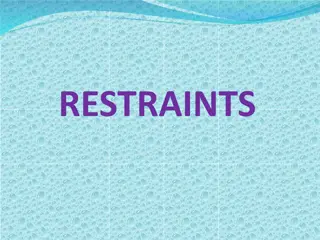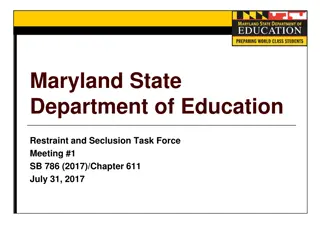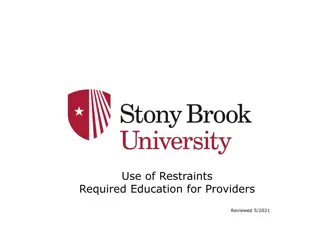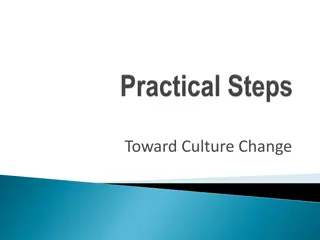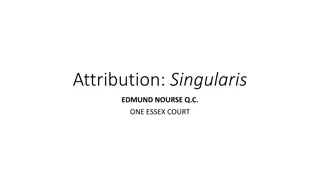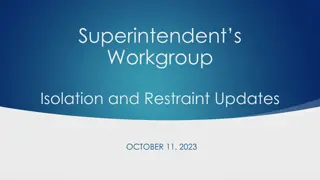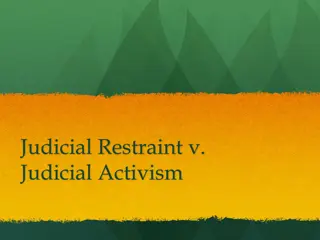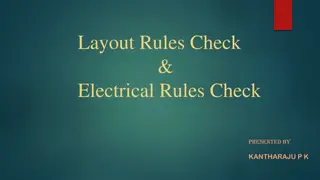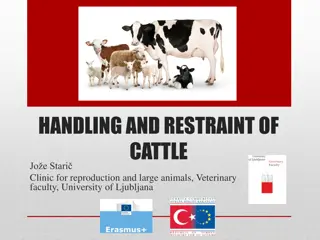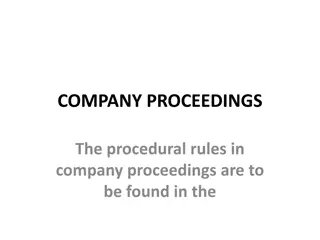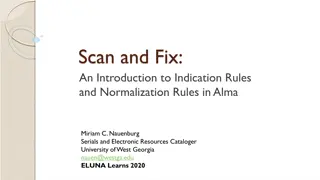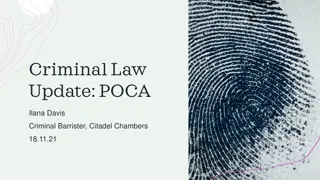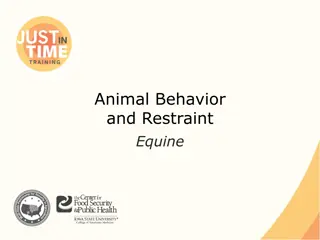Restraint and Seclusion Rules in Education
The essential aspects of Chapter 33 rule on restraint and seclusion in education, covering impacts, types, lawful usage, reporting, and alternatives to ensure safety and compliance.
Download Presentation

Please find below an Image/Link to download the presentation.
The content on the website is provided AS IS for your information and personal use only. It may not be sold, licensed, or shared on other websites without obtaining consent from the author. Download presentation by click this link. If you encounter any issues during the download, it is possible that the publisher has removed the file from their server.
E N D
Presentation Transcript
Chapter 33 Seclusion and Restraint: Overview and Awareness Timelines, Requirements and Local Policy This Annual course is to align with MDOE Rule Chapter 33 and the law outlined in Title 20-A MRSA 4014 This course DOES NOT meet the requirement of having a sufficient number of administrators or designees, general and special education staff, maintain certification in an approved training (Section 12)
This Annual course is to align with MDOE Chapter 33 rule policies and procedures Intention of This Training: This course is not to be used as crisis response training or to recommend policies or procedures Upon completion, this training will have provided a foundational knowledge of basic principles of restraint and seclusion and the key aspects of the Chapter 33 rule.
Develop an awareness and understanding of Chapter 33 rule Goals For This Training: Be aware of impacts of use of Restraint and Seclusion Define and identify different types of Restraint and Seclusion Be able to identify lawful and unlawful uses of Restraint and Seclusion Understand expectations of reporting Identify possible alternatives to Restraint and Seclusion
What is Chapter 33?? Maine laws consist of Statute o Maine Statute Statute is cited under Title: 20-A is education State Statute symbol ( ) and number then section heading and subsections: example: 20-A MRSA 4014 sec (1)F 20-A MRSA 4014. Use of seclusion and physical restraint o Chaptered Rules are based on statute and are regulatory Provide additional specifics that are in line with statute to provide an outline for compliance with the law The Chapter 33 Rule establishes standards and procedures for the use of physical restraint and seclusion in schools. Education Rules are cited under 05-071 (education general rule) Then Chapter number, section heading and subsections example: 05-071 Chapt. 33 sec (6)(3)B
Why is the Chapter 33 Rule Important? The use of Restraint and Seclusion (R&S) carries inherent risk of physical and/or emotional harm to both the student and educator and can have very serious consequences, including, most tragically, death. The use of R&S as an intervention can pose a real risk of lasting emotional harm to students, particularly those who have experienced violence or trauma. There continues to be no evidence that the use of restraint or seclusion, as a behavior intervention or as a punishment, is effective in reducing the occurrence of problem behaviors. (USDOE 2019) Chapter 33 Rule specifies that use of R&S is limited to an emergency intervention Chapter 33 Rule was created to clearly set expectations for safety, reduce the overall use of R&S and ultimately, to protect students and staff.
Why Restraint and Seclusion are only used as an Emergency Response: Possible Impacts: Physical Risks: Can lead to student AND staff physical injuries Sprains, bruises Broken bones Death Psychological/Emotional Risks: Can traumatize or re-traumatize students and staff Can reduce cognitive skill development through reliance of restraint over increasing brain regulation Harm can happen even in attempting to restrain or seclude Can create a toxic us vs. them mentality which de-personalizes both student and staff Can develop a physiological safety response that leads to increased dysregulation and more negative behavior Airbag Analogy
Use of Restraint in Schools Definitions Permitted Use under Chapter 33 Law Monitoring
What is a Restraint? Three kinds of restraint: The third kind is the only type of restraint that can be considered in schools and then, only as an emergency intervention The first two should never be used in a school environment! 1. Chemical Restraint: The unsanctioned use of medication or chemicals to inhibit a person s freedom of movement. 20-A MRSA 4014 sec (1)(I)2 3. Physical Restraint: A personal restriction that immobilizes or reduces the ability of a student to move the arms, legs, or head freely and includes physically moving a student who has not moved voluntarily. 20-A MRSA 4014 sec (1)F Mechanical Restraint: 20-A MRSA 4014 sec (1)C The use of any device to restrict a person s freedom of movement. Does NOT include: seatbelts, adaptive devices or those that are medically prescribed. o
The following interventions are NOT included in the definition of physical restraint: Mechanical and Chemical Restraints 20-A MRSA 4014 sec (1)F Protective Physical Interventions: Used when a student s actions would be harmful to themselves or others, and involve physical contacts that serve to deflect, block, or redirect the student s action or disengage from a student s inappropriate grip, but from which the student could move freely away. 05-071Chapt. 33 sec (2)(16)(A)5 Physical Prompt: Ateaching technique that involves voluntary physical contact with a student that enables the student to learn or model the physical movement necessary for the development of a desired competency 20-A MRSA 4014 sec (1)F Physical contact when the purpose of the intervention is to comfort a student and the student voluntarily accepts the contact 05-071Chapt. 33 sec (2)(16)(A)6 Physical Escort: The temporary, voluntary touching or holding of the hand, wrist, arm, shoulder, or back to induce a student to walk to a safe location. 20-A MRSA 4014 sec (1)F
When Physical Restraint is Permitted: Only as an emergency intervention, when the student s behavior poses an imminent danger of serious physical injury to the student or another person 20-A MRSA 4014 sec (2) Physical restraint must be implemented by staff certified in a state-approved training program to the extent possible. o If, due to the nature of the emergency, untrained staff have intervened and initiated a physical restraint and if the need for physical restraint continues, trained personnel must be summoned to the scene and must assume control of the situation as rapidly as possible. 05-071Chapt. 33 sec (6)(1)F Only after other less intrusive interventions have failed or been deemed inappropriate, and with the least amount of force necessary 20-A MRSA 4014 sec (2) Physical restraint may be used to move a student only if the need for movement outweighs the risks involved in such movement. 05-071Chapt. 33 sec (6)(1)G The restraint ends immediately upon the cessation of imminent danger of serious physical injury to the student or another person. 20-A MRSA 4014 sec (2)
Definitions Matter: Imminent Danger Describes a situation in which a student has: Serious Physical Injury Is any impairment of the physical condition of a person: The means to cause physical harm or injury to self or others; and Either self inflicted or inflicted by someone else and Injury or harm is likely to occur; such that a reasonable and prudent person would take steps to protect the student and others against the risk of such injury or harm. 05-071Chapt. 33 sec (2)8 Used when a student s actions would be harmful to themselves or others They involve physical contacts that serve to deflect, block, or redirect the student s action Or disengage from a student s inappropriate grip From which the student could move freely away. 05-071Chapt. 33 sec (2)18 Is beyond the care of routine first aid, and should require a medical practitioner to evaluate and/or to treat the victim. 05-071Chapt. 33 sec (2)23 Protective physical interventions
Physical restraint is unlawful for use in the following ways: For punitive purposes or as a control for challenging behavior Physical restraint or physical escort that is life-threatening, restricts breathing or blood flow to the brain, including prone restraint 05-071Chapt. 33 sec (6)(2)E As a therapeutic or educational intervention 05-071Chapt. 33 sec (6)(2)H For staff convenience 05-071Chapt. 33 sec (6)(2)E 20-A MRSA 4014 sec (1)(I)3 Any restraint that relies on pain for control 05-071Chapt. 33 sec (6)(2)G To prevent property destruction or disruptionin the absence of immediate risk of injury Any aversive procedures, mechanical or chemical restraints 05-071Chapt. 33 sec (6)(2)F When contraindicated as documented in a health care directive, behavior intervention plan or IEP 20-A MRSA 4014 sec (1)(I)4 05-071Chapt. 33 sec (6)(2)I
Restraint Must be Monitored If a restraint is used on a student, at least two adults must be present at all times, except when, for safety reasons, waiting for a second adult is precluded. 05-071Chapt. 33 sec (6)(3)A If, due to the nature of the emergency, untrained staff have intervened and initiated a physical restraint and if the need for physical restraint continues, trained personnel must be summoned to the scene and must assume control of the situation as rapidly as possible. 05-071Chapt. 33 sec (6)(1)F Monitoring should include making sure that student airways are unimpeded and in the event of an injury, local policy must be followed. Monitoring should also include ensuring that staff are emotionally regulated and using only proscribed restraints appropriate to maintaining safety. Monitoring must be continuous until the restraint is terminated. 05-071Chapt. 33 sec (6)(3)B
Termination of Physical Restraint Any restraint must end immediately once the student is no longer presenting an imminent danger of serious physical injury to self or others. 20-A MRSA 4014 sec (2)C If any restraint continues for more than 10 minutes, an administrator or designee must determine whether continued restraint is required for safety and continues to monitor every 10 minutes until terminated. 05-071Chapt. 33 sec (6)(4)E Time must be recorded consistent with the requirements of Chapter 33 documentation guidelines and local policy. 05-071Chapt. 33 sec (6)(4)B If attempts to terminate a restraint have been unsuccessful, staff may request assistance from outside sources and may request assistance from outside sources such as caregivers, case managers, crisis intervention teams, local EMS, or other community resources. 05-071Chapt. 33 sec (6)(4)D
Use of Seclusion in Schools Definitions Permitted Use under Chapter 33 Law Location Monitoring
What is Seclusion? Seclusion is the involuntary confinement of a student alone in a room or clearly defined area from which the student does not feel free to go or is physically denied exit. 20-A MRSA 4014 sec (1)G Seclusion does not include the use of timeout as defined in the rule as: o an intervention where a student requests or complies with an adult request for a break. 20-A MRSA 4014 sec (1)H.
When Seclusion is Permitted: Only as an emergency intervention when the behavior of a student presents an imminent danger of serious physical injury to the student or another person 20-A MRSA 4014 sec (2)A Only after other less restrictive interventions have failed or been deemed inappropriate 20-A MRSA 4014 sec (2)B Seclusion must be implemented by staff certified in a state- approved training program to the extent possible. o If, due to the nature of the emergency, untrained staff have intervened and initiated a seclusion and if the need for seclusion continues, trained personnel must be summoned to the scene and must assume control of the situation as rapidly as possible. 20-A MRSA 4014 sec (2)F The seclusion ends immediately upon the cessation of imminent danger of serious physical injury to the student or another person. 20-A MRSA 4014 sec (2)D
Definitions Matter: Imminent Danger Describes a situation in which a student has: Serious Physical Injury Is any impairment of the physical condition of a person: The means to cause physical harm or injury to self or others; and Either self inflicted or inflicted by someone else and Injury or harm is likely to occur; such that a reasonable and prudent person would take steps to protect the student and others against the risk of such injury or harm. 05-071Chapt. 33 sec (2)8 Is beyond the care of routine first aid, and should require a medical practitioner to evaluate and/or to treat the victim. 05-071Chapt. 33 sec (2)23 Means that a student cooperates with a request, independent of staff using physical force for the purpose of overcoming a student s resistance. 05-071Chapt. 33 sec (2)27 Voluntary
Seclusion is unlawful if used in the following ways: In a locked room For punitive purposes or as a control for challenging behavior 05-071Chapt. 33 sec (5)(2)D To prevent property destruction or disruption in the absence of immediate risk of injury 05-071Chapt. 33 sec (5)(2)A For staff convenience 05-071Chapt. 33 sec (5)(2)A As a threat to change student behavior When contraindicated as documented in a health care directive, behavior intervention plan or IEP 20-A MRSA 4014 sec (1)(I)4 05-071Chapt. 33 sec (5)(2)B As a therapeutic or educational intervention. 05-071Chapt. 33 sec (5)(2)C
Seclusion Must be Monitored If seclusion is used on a student, one adult must be physically present to continuously monitor the student at all times. 05-071Chapt. 33 sec (5)(3)A The student who is secluded must be visible at all times to monitoring staff. 05-071Chapt. 33 sec (5)(3)A Monitoring must be continuous and include making sure that students are not at risk of harming themselves while seclusion is used and in the event of an injury, local policy must be followed. 05-071Chapt. 33 sec (5)(3)B&C Monitoring should also include ensuring that staff are emotionally regulated and are following appropriate guidelines in maintaining student physical and emotional safety.
Termination of Seclusion Any seclusion must end immediately upon the cessation of imminent danger of serious physical injury to the student or another person. 20-A MRSA 4014 sec (2)C If any seclusion continues for more than 10 minutes,an administrator or designee must determine whether continued seclusion is warranted for safety and continuesto monitor every 10 minutes until terminated. 05-071Chapt. 33 sec (5)(4)E If attempts to terminate a seclusion have been unsuccessful, staff may request assistance from outside sources and may request assistance from outside sources such as caregivers, case managers, crisis intervention teams, local EMS, or other community resources. 05-071Chapt. 33 sec (5)(4)D
Location of Seclusion While the location of seclusion may occur in any part of a school s building or premises, the following basic needs must be met: Adequate light, heat, ventilation and normal room height 05-071Chapt. 33 sec (5)5 If a specific room is designated as a seclusion room , it must meet the following guidelines: Minimum of 60 square feet Adequate light, heat, ventilation and normal room height Contain an unbreakable observation window in a wall or door Free of hazardous material and objects with which a student could self-inflict bodily injury 05-071Chapt. 33 sec (5)(5)A
Notification and Response After an Incident of Restraint & Seclusion Notification Documentation Debriefing
What is an incident? Means all actions from the time a student s behavior begins to create a risk of harm, to the time the student ceases to pose a risk of harm and returns to their regular programming. 05-071Chapt. 33 sec (2)9 If within the time of an incident, a restraint or a seclusion happens, then the notification process must be followed. 05-071Chapt. 33 sec (7)1 o Includes the use of any and all uses of lawful AND unlawful restraint or seclusion o Multiple uses of restraints and/or seclusions may happen within one incident, prompting one notification
Notification of Incident School Administrator or Designee 05-071Chapt. 33 sec (7)1 o Orally, ASAP but no later than end of schoolday o Out of district placement, by phone within 24 hours (or next school day) Parents 05-071Chapt. 33 sec (7)2 o By administrator (or designee) ASA Practical but no later than same school day; leave phone message if necessary or use emergency contact info o If occurs outside school day, ASAP following emergency protocol o Must be provided written documentation within 7 calendar days Serious Bodily Injury or Death 05-071Chapt. 33 sec (7)3 o Oral notification must follow local health & safety procedures outlined by the school s policies o Administrators notify the DOE within 24 hours or next school day
Documentation: Incident Report 05-071Chapt. 33 sec (8)1 Must include notation of o Date, time, location and persons involved o If student has an IEP or 504 plan o Each use of restraint and/or seclusion o Specific description of events leading to incident, less restrictive interventions and resolution of process Needs to be completed and provided to admin or designee o As soon as practical after the incident and o within 2 school days 05-071Chapt. 33 sec (8)(1)B Parents must be provided the report within 7 calendar days 05-071Chapt. 33 sec (8)2
Debriefing: Incident Review 05-071Chapt. 33 sec (9)1 Within 2 school days of incident; OR no later than the next school day, if the incident resulted in serious bodily injury 1. Review with staff who implemented restraint and/or seclusion o Whether use of restraint and/or seclusion was implemented in compliance with the rule and local policies o How to prevent or reduce future need for emergency intervention 2. Review with student who was restrained and/or secluded o What led to the student s escalation and o What the student and staff can do to prevent future need for emergency intervention 3. Following the debriefing, staff must develop and implement a written plan for response and de-escalation for the student, or, if a plan already exists, staff must review and, if appropriate, revise it.
After Every 3 Incidents: Students who have IEP/504 plans: 05-071Chapt. 33 sec (9)(2)A After every three Incidents the IEP/504 team shall meet within 10 school days The team will discuss the incident and consider the need for a FBA or BIP or amending an existing one For all other students: 05-071Chapt. 33 sec (9)(2)B After every three Incidents a team shall meet within 10 school days The team shall consist of the parent, an administrator, a teacher of the student, a staff member involved in the incident and other appropriate staff The team will consider the appropriateness of a referral to special services The need for a FBA or BIP or amending an existing one *Schools are not required to hold more than one meeting within any 30-school-day period 05-071Chapt. 33 sec (9)2
Staff Training & Approved Programs: Training for Staff 05-071Chapt. 33 sec (12) Districts shall ensure that a sufficient number of staff, maintain certification in an approved training program. A list of staff with the required approved training must be made available in each building office, as well as any central office, along with other school-wide emergency procedures and must be updated at least annually. Approved Programs 05-071Chapt. 33 sec (12) The MDOE maintains a list of approved programs that districts may choose to train staff. All programs include the following core components: o Non-physical interventions, de-escalation and positive alternatives o Identification of dangerous behaviors that may indicate the need for intervention o Simulated experience in administering restraint techniques o Impacts of restraint and seclusion on a student o Risks and realities of restraint and seclusion o Review of staff and student debriefing
How we can reduce restraint and seclusion: An emergency is too late Research for reducing negative behavior or dysregulated responses shows that intervention needs to occur well before a situation begins to escalate Successful interventions are not provided in response to behavior but are part of a whole child approach that can include o Whole school approaches that foster safe and connected school cultures o Incorporate trauma informed trainings for all staff that include neurological response and developmental impacts o Systems to increase student inclusion in general education classes through staff training and support o Relational based approaches for collaboratively working with students to support the learning of emotional regulation skills o Shift from a punitive discipline to a restorative model where students are held accountable by their community rather than being removed from it Research shows that just by having a genuine, connected relationship with a student, can significantly reduce dysregulated behavior and increase student engagement and success We have schools in Maine that have reduced their use of restraint and seclusion through intentionally incorporating best-practice strategies.
Take Aways: The Chapter 33 Rule outlines how restraint and seclusion is to be used in schools and is in line with state law 20-A MRSA 4014. Due to the risks of injury and negative impacts, restraint and seclusion are only used as emergency interventions. Restraint and seclusion are not used to punish, threaten, control challenging behavior or prevent property damage Chapter 33 Rule provides guidelines for documenting, reporting and debriefing incidents where restraint and/or seclusion were used Reducing the use of restraint and seclusion can be achieved through prevention and trauma informed relational approaches Your administrator will review any additional local policies and procedures related to Chapter 33 Rule
Thank You! With great appreciation, for all the work you do to create a learning environment where students can excel, we at the MDOE thank you for supporting Maine students, their families and your community.
Resources: Maine Dept. of Education Webpage https://www.maine.gov/doe/schools/safeschools/restraint Statue and Chapter 33 information List of approved training programs Rule guidance, trainings and resources Reducing restraint and seclusion in schools initiative United States Dept. of Education Webpage https://www2.ed.gov/policy/seclusion/index.html Publications and research Resource document Federal policy Statute Link 20-A MRSA 4014. Use of seclusion and physical restraint
